Landcover Change in Tigray’s Semi-Arid Highlands (1935–2020): Implications for Runoff and Channel Morphology
Abstract
1. Introduction
- What are the magnitude and spatial patterns of changes in landcover and drainage network characteristics in the Tsili catchment over the past 85 years?
- What is the relationship between landcover change and hydrological response, including surface runoff, gully formation, and drainage network expansion?
- Can spatial variations in river channel width reflect broader hydrological changes, and thus support runoff modelling and interpretation in regions with limited field data?
2. Materials and Methods
2.1. The Tsili Catchment
2.2. Landcover and Drainage Network Mapping
| Source | Date of Acquisition | Type | Period |
|---|---|---|---|
| Nyssen et al. [44]; | 2 November 1935 | Aerial | 1930s |
| Ethiopian Mapping Authority | 31 January 1964 16 December 1967 | Aerial | 1960s |
| Ethiopian Mapping Authority | 1994 | Aerial | 1990s |
| Google Earth [40] | 25 September 2020 | Satellite | 2020s |
2.3. River Channel Width Measurement
2.4. Runoff Response Modelling
2.5. Data Analysis
3. Results
3.1. Landcover and Drainage Network
3.2. River Channel Width
3.3. Impact of Landcover and Drainage Network Change on Modelled Runoff Response
3.4. Impact of Landcover and Drainage Network Change on Surface Runoff and River Channel Width
4. Discussion
4.1. Long Term Landcover Changes in the Tsili Catchment
4.2. Landcover Change and Its Hydrological Response
4.3. Interpreting Model Outputs Amid Data Scarcity
5. Conclusions
Author Contributions
Funding
Data Availability Statement
Acknowledgments
Conflicts of Interest
Abbreviations
| a.s.l. | Above sea level |
| DEM | Digital Elevation Model |
| dpi | Dots per inch |
| GCPs | Ground control points |
| HRU | Hydrological Response Unit |
| RC | Runoff coefficient |
| SRTM | Shuttle Radar Topography Mission |
| SWAT | Soil and Water Assessment Tool |
Appendix A. Illustrations of the Visual Interpretation of the Aerial Imagery
| Landcover Class | Sample Image |
|---|---|
| Forest—Dense agglomerations of trees | 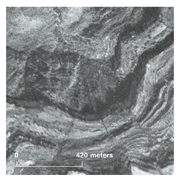 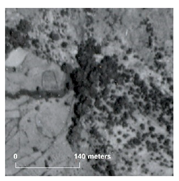 |
| Shrubland—Alternation of grass, shrubs and trees, predominantly shrubs |   |
| Grassland—Predominantly grass | 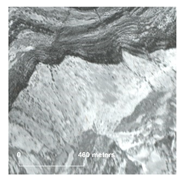  |
| Cropland—Agricultural area (patchiness and plot boundaries) | 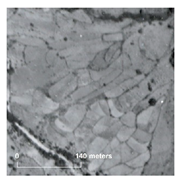 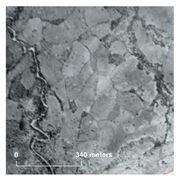 |
| Village—Low density populated area |  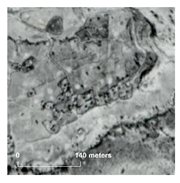 |
| Landcover Class | Sample Image |
|---|---|
| Forest—Dense agglomerations of trees | 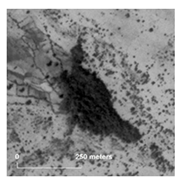 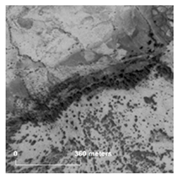 |
| Shrubland—Alternation of grass, shrubs and trees, predominantly shrubs | 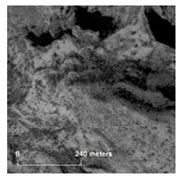 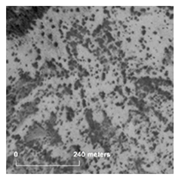 |
| Grassland—Predominantly grass |   |
| Cropland—Agricultural area (patchiness and plot boundaries) |  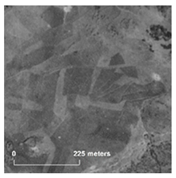 |
| Village—Low density populated area |  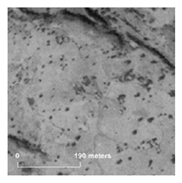 |
| Landcover Class | Sample Image |
|---|---|
| Forest—Dense agglomerations of trees | 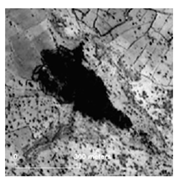  |
| Shrubland—Alternation of grass, shrubs and trees, predominantly shrubs | 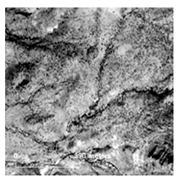 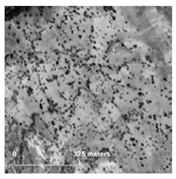 |
| Grassland—Predominantly grass | 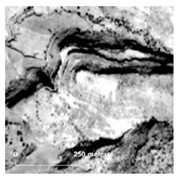 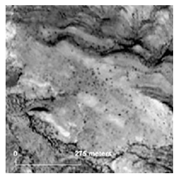 |
| Cropland—Agricultural area (patchiness and plot boundaries) | 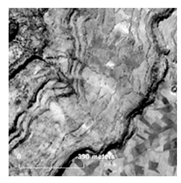  |
| Village—Low density populated area | 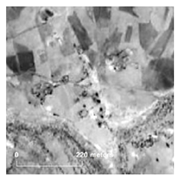 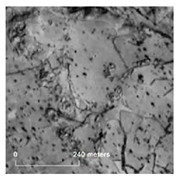 |
| Landcover Class | Sample Image |
|---|---|
| Forest—Dense agglomerations of trees | 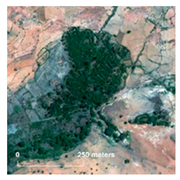 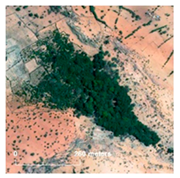 |
| Shrubland—Alternation of grass, shrubs and trees, predominantly shrubs | 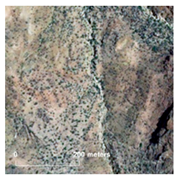  |
| Grassland—Predominantly grass | 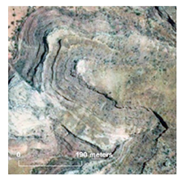 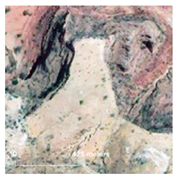 |
| Cropland—Agricultural area (patchiness and plot boundaries) | 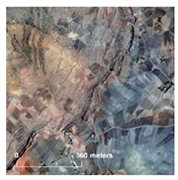 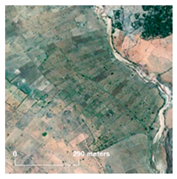 |
| Village—Low density populated area | 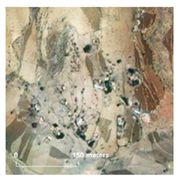 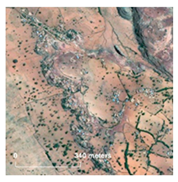 |
References
- Lambin, E.F.; Geist, H.J.; Lepers, E. Dynamics of Land-Use and Land-Cover Change in Tropical Regions. Annu. Rev. Environ. Resour. 2003, 28, 205–241. [Google Scholar] [CrossRef]
- Gibbs, H.K.; Ruesch, A.S.; Achard, F.; Clayton, M.K.; Holmgren, P.; Ramankutty, N.; Foley, J.A. Tropical Forests Were the Primary Sources of New Agricultural Land in the 1980s and 1990s. Proc. Natl. Acad. Sci. USA 2010, 107, 16732–16737. [Google Scholar] [CrossRef]
- Song, X.P.; Hansen, M.C.; Stehman, S.V.; Potapov, P.V.; Tyukavina, A.; Krylov, A.; Townshend, J.R. Global Land Change from 1982 to 2016. Nature 2018, 560, 639–643. [Google Scholar] [CrossRef] [PubMed]
- Sisay, G.; Gitima, G.; Mersha, M.; Alemu, W.G. Assessment of Land Use Land Cover Dynamics and Its Drivers in Bechet Watershed Upper Blue Nile Basin, Ethiopia. Remote Sens. Appl. Soc. Environ. 2021, 24, 100648. [Google Scholar] [CrossRef]
- FAO; UNEP. Land Cover Classification System: Based on the UN Land Cover Classification System (LCCS); Food and Agriculture Organization of the United Nations; United Nations Environment Programme: Rome, Italy, 1997. [Google Scholar]
- Meire, E.; Frankl, A.; De Wulf, A.; Haile, M.; Deckers, J.; Nyssen, J. Land Use and Cover Dynamics in Africa since the Nineteenth Century: Warped Terrestrial Photographs of North Ethiopia. Reg. Environ. Change 2013, 13, 717–737. [Google Scholar] [CrossRef]
- Etefa, G.; Frankl, A.; Lanckriet, S.; Biadgilgn, D.; Gebreyohannes, Z.; Amanuel, Z.; Poesen, J.; Nyssen, J. Changes in Land Use/Cover Mapped over 80 Years in the Highlands of Northern Ethiopia. J. Geogr. Sci. 2018, 28, 1538–1563. [Google Scholar] [CrossRef]
- Nyssen, J.; Tielens, S.; Gebreyohannes, T.; Araya, T.; Teka, K.; Van De Wauw, J.; Degeyndt, K.; Descheemaeker, K.; Amare, K.; Haile, M.; et al. Understanding Spatial Patterns of Soils for Sustainable Agriculture in Northern Ethiopia’s Tropical Mountains. PLoS ONE 2019, 14, e0224041. [Google Scholar] [CrossRef]
- Lanckriet, S.; Derudder, B.; Naudts, J.; Bauer, H.; Deckers, J.; Haile, M.; Nyssen, J. A Political Ecology Perspective of Land Degradation in the North Ethiopian Highlands. Land Degrad. Dev. 2014, 26, 521–530. [Google Scholar] [CrossRef]
- Nyssen, J.; Frankl, A.; Zenebe, A.; Deckers, J.; Poesen, J. Land Management in the Northern Ethiopian Highlands: Local and Global Perspectives; Past, Present and Future. Land Degrad. Dev. 2015, 26, 759–764. [Google Scholar] [CrossRef]
- Descheemaeker, K.; Nyssen, J.; Poesen, J.; Raes, D.; Haile, M.; Muys, B.; Deckers, S. Runoff on Slopes with Restoring Vegetation: A Case Study from the Tigray Highlands, Ethiopia. J. Hydrol. 2006, 331, 219–241. [Google Scholar] [CrossRef]
- Bracken, L.J.; Croke, J. The Concept of Hydrological Connectivity and Its Contribution to Understanding Runoff-Dominated Geomorphic Systems. Hydrol. Process. 2007, 21, 1749–1763. [Google Scholar] [CrossRef]
- Lexartza-Artza, I.; Wainwright, J. Hydrological Connectivity: Linking Concepts with Practical Implications. CATENA 2009, 79, 146–152. [Google Scholar] [CrossRef]
- Bracken, L.J.; Wainwright, J.; Ali, G.A.; Tetzlaff, D.; Smith, M.W.; Reaney, S.M.; Roy, A.G. Concepts of Hydrological Connectivity: Research Approaches, Pathways and Future Agendas. Earth-Sci. Rev. 2013, 119, 17–34. [Google Scholar] [CrossRef]
- Wohl, E.; Brierley, G.; Cadol, D.; Coulthard, T.J.; Covino, T.; Fryirs, K.A.; Grant, G.; Hilton, R.G.; Lane, S.N.; Magilligan, F.J.; et al. Connectivity as an Emergent Property of Geomorphic Systems: Geomorphic Connectivity. Earth Surf. Process. Landf. 2019, 44, 4–26. [Google Scholar] [CrossRef]
- McIntyre, N.; Ballard, C.; Bruen, M.; Bulygina, N.; Buytaert, W.; Cluckie, I.; Dunn, S.; Ehret, U.; Ewen, J.; Gelfan, A.; et al. Modelling the Hydrological Impacts of Rural Land Use Change. Hydrol. Res. 2014, 45, 737–754. [Google Scholar] [CrossRef]
- Rey, F. Effectiveness of Vegetation Barriers for Marly Sediment Trapping. Earth Surf. Process. Landf. 2004, 29, 1161–1169. [Google Scholar] [CrossRef]
- van Dijk, A.I.J.M.; Keenan, R.J. Planted Forests and Water in Perspective. For. Ecol. Manag. 2007, 251, 1–9. [Google Scholar] [CrossRef]
- Pan, C.; Ma, L.; Shangguan, Z.; Ding, A. Determining the Sediment Trapping Capacity of Grass Filter Strips. J. Hydrol. 2011, 405, 209–216. [Google Scholar] [CrossRef]
- Pan, D.; Gao, X.; Dyck, M.; Song, Y.; Wu, P.; Zhao, X. Dynamics of Runoff and Sediment Trapping Performance of Vegetative Filter Strips: Run-on Experiments and Modeling. Sci. Total Environ. 2017, 593–594, 54–64. [Google Scholar] [CrossRef] [PubMed]
- Liu, Y.-J.; Hu, J.-M.; Wang, T.-W.; Cai, C.-F.; Li, Z.-X.; Zhang, Y. Effects of Vegetation Cover and Road-Concentrated Flow on Hillslope Erosion in Rainfall and Scouring Simulation Tests in the Three Gorges Reservoir Area, China. CATENA 2016, 136, 108–117. [Google Scholar] [CrossRef]
- Brink, A.B.; Eva, H.D. Monitoring 25 Years of Land Cover Change Dynamics in Africa: A Sample Based Remote Sensing Approach. Appl. Geogr. 2009, 29, 501–512. [Google Scholar] [CrossRef]
- Gebremicael, T.G.; Mohamed, Y.A.; Hagos, E.Y. Temporal and Spatial Changes of Rainfall and Streamflow in the Upper Tekezē–Atbara River Basin, Ethiopia. Hydrol. Earth Syst. Sci. 2017, 21, 2127–2142. [Google Scholar] [CrossRef]
- Solomon, N.; Hishe, H.; Annang, T.; Pabi, O.; Asante, I.K.; Birhane, E. Forest Cover Change, Key Drivers and Community Perception in Wujig Mahgo Waren Forest of Northern Ethiopia. Land 2018, 7, 32. [Google Scholar] [CrossRef]
- Betru, T.; Tolera, M.; Sahle, K.; Kassa, H. Trends and Drivers of Land Use/Land Cover Change in Western Ethiopia. Appl. Geogr. 2019, 104, 83–93. [Google Scholar] [CrossRef]
- Intergovernmental Panel on Climate Change (IPCC). Climate Change and Land: IPCC Special Report on Climate Change, Desertification, Land Degradation, Sustainable Land Management, Food Security, and Greenhouse Gas Fluxes in Terrestrial Ecosystems, 1st ed.; Cambridge University Press: Cambridge, UK, 2022; ISBN 978-1-009-15798-8. [Google Scholar]
- Leta, M.K.; Demissie, T.A.; Tränckner, J. Hydrological Responses of Watershed to Historical and Future Land Use Land Cover Change Dynamics of Nashe Watershed, Ethiopia. Water 2021, 13, 2372. [Google Scholar] [CrossRef]
- Kayitesi, N.M.; Guzha, A.C.; Mariethoz, G. Impacts of Land Use Land Cover Change and Climate Change on River Hydro-Morphology: A Review of Research Studies in Tropical Regions. J. Hydrol. 2022, 615, 128702. [Google Scholar] [CrossRef]
- Conway, D.; Persechino, A.; Ardoin-Bardin, S.; Hamandawana, H.; Dieulin, C.; Mahé, G. Rainfall and Water Resources Variability in Sub-Saharan Africa during the Twentieth Century. J. Hydrometeorol. 2009, 10, 41–59. [Google Scholar] [CrossRef]
- Dile, Y.T.; Srinivasan, R. Evaluation of CFSR Climate Data for Hydrologic Prediction in Data-Scarce Watersheds: An Application in the Blue Nile River Basin. J. Am. Water Resour. Assoc. 2014, 50, 1226–1241. [Google Scholar] [CrossRef]
- Samimi, M.; Mirchi, A.; Moriasi, D.; Ahn, S.; Alian, S.; Taghvaeian, S.; Sheng, Z. Modeling Arid/Semi-Arid Irrigated Agricultural Watersheds with SWAT: Applications, Challenges, and Solution Strategies. J. Hydrol. 2020, 590, 125418. [Google Scholar] [CrossRef]
- Arkin, Y.; Beyth, M.; Dow, B.D.; Levitte, D.; Temesgen, H.; Tsegaye, H. Geological Map of Mekele Sheet Area ND 37-11; Ministry of Mines Geological Survey of Ethiopia: Addis Ababa, Ethiopia, 1971. [Google Scholar]
- Tefera, M.; Chernet, T.; Haro, W. Explanation of the Geological Map of Ethiopia (1:2,000,000); Ethiopian Institute of Geological Surveys: Addis Ababa, Ethiopia, 1996. [Google Scholar]
- Pik, R.; Deniel, C.; Coulon, C.; Yirgu, G.; Hofmann, C.; Ayalew, D. The Northwestern Ethiopian Plateau Flood Basalts: Classification and Spatial Distribution from the Simien to Tigray Plateaus. J. Volcanol. Geotherm. Res. 1998, 81, 91–111. [Google Scholar] [CrossRef]
- Wolfenden, E.; Ebinger, C.J.; Yirgu, G.; Deino, A.; Ayalew, D. Evolution of the Northern Main Ethiopian Rift: Birth of a Triple Junction. Earth Planet. Sci. Lett. 2004, 224, 213–228. [Google Scholar] [CrossRef]
- IUSS Working Group WRB. World Reference Base for Soil Resources; International Soil Classification System for Naming Soils and Creating Legends for Soil Maps, 4th ed.; Schad, P., Mantel, S., Anjos, L., Boixadera Llobet, J., Deckers, S., Dondeyne, S., Eberhardt, E., Gerasimova, M., Harms, B., Kabala, C., et al., Eds.; International Union of Soil Sciences (IUSS): Vienna, Austria, 2022; ISBN 979-8-9862451-1-9. [Google Scholar]
- Nicholson, S.E. Climate and Climatic Variability of Rainfall over Eastern Africa. Rev. Geophys. 2017, 55, 590–635. [Google Scholar] [CrossRef]
- Nicholson, S.E. The ITCZ and the Seasonal Cycle over Equatorial Africa. Bull. Am. Meteorol. Soc. 2018, 99, 337–348. [Google Scholar] [CrossRef]
- Nyssen, J.; Jacob, M.; Frankl, A. (Eds.) Geo-Trekking in Ethiopia’s Tropical Mountains: The Dogu’a Tembien District; GeoGuide; Springer: Cham, Switzerland, 2019; ISBN 978-3-030-04954-6. [Google Scholar]
- Google Earth. High-Resolution Satellite Imagery of Dogu’a Tembien, Ethiopia of 2020. Available online: https://earth.google.com (accessed on 19 September 2024).
- Nyssen, J.; Petrie, G. Historical Aerial Photography of Ethiopia Recovery & Organisation of Important Documentation from the 1930s. Geoinformatics 2013, 16, 32–36. [Google Scholar]
- Debever, M. Semi-Automated Land Use/Land Cover Extraction from Historical Aerial Photographs: A Case Study in Dogu’a Tembien (Ethiopia) over the Period 1935–1994. Master’s Thesis, University Ghent, Ghent, Belgium, 2019. [Google Scholar]
- QGIS Development Team. QGIS Geographic Information System 2021. Open Source Geospatial Foundation Project. Available online: https://qgis.org/download/ (accessed on 24 February 2022).
- Nyssen, J.; Petrie, G.; Mohamed, S.; Gebremeskel, G.; Seghers, V.; Debever, M.; Hadgu, K.M.; Stal, C.; Billi, P.; Demaeyer, P.; et al. Recovery of the Aerial Photographs of Ethiopia in the 1930s. J. Cult. Herit. 2016, 17, 170–178. [Google Scholar] [CrossRef]
- Pontius, R.G.; Shusas, E.; McEachern, M. Detecting Important Categorical Land Changes While Accounting for Persistence. Agric. Ecosyst. Environ. 2004, 101, 251–268. [Google Scholar] [CrossRef]
- Esri. ArcMap [GIS Software], Version 10.6.1; Esri: Redlands, CA, USA, 2018.
- Gassman, P.W.; Reyes, M.R.; Green, C.H.; Arnold, J.G. The Soil and Water Assessment Tool: Historical Development, Applications, and Future Research Directions. Trans. ASABE 2007, 50, 1211–1250. [Google Scholar] [CrossRef]
- Neitsch, S.L.; Arnold, J.G.; Kiniry, J.R.; Williams, J.R. Soil & Water Assessment Tool Theoretical Documentation Version 2009; Texas Water Resources Institute: College Station, TX, USA, 2009. [Google Scholar]
- Arnold, J.G.; Moriasi, D.N.; Gassman, P.W.; Abbaspour, K.C.; White, M.J.; Srinivasan, R.; Santhi, C.; Harmel, R.D.; Van Griensven, A.; Van Liew, M.W.; et al. SWAT: Model Use, Calibration, and Validation. Trans. ASABE 2012, 55, 1491–1508. [Google Scholar] [CrossRef]
- Pereira, D.; Afonso, A.; Medeiros, F. Overview of Friedman’s Test and Post-Hoc Analysis. Commun. Stat. Simul. Comput. 2015, 44, 2636–2653. [Google Scholar] [CrossRef]
- Govender, T.; Dube, T.; Shoko, C. Remote Sensing of Land Use-Land Cover Change and Climate Variability on Hydrological Processes in Sub-Saharan Africa: Key Scientific Strides and Challenges. Geocarto Int. 2022, 37, 10925–10949. [Google Scholar] [CrossRef]
- Mahé, G. The Impacts of Land-Use/Land-Cover Change and Climate Variability on the Hydrology of the Sahel. In Proceedings of the 5th FRIEND World Conference; IAHS Press: Havanna, Cuba, 2006; Volume 308, pp. 679–684. [Google Scholar]
- Ruelland, D.; Dezetter, A.; Puech, C.; Ardoin-Bardin, S. Long-term Monitoring of Land Cover Changes Based on Landsat Imagery to Improve Hydrological Modelling in West Africa. Int. J. Remote Sens. 2008, 29, 3533–3551. [Google Scholar] [CrossRef]
- Guzha, A.C.; Rufino, M.C.; Okoth, S.; Jacobs, S.; Nóbrega, R.L.B. Impacts of Land Use and Land Cover Change on Surface Runoff, Discharge and Low Flows: Evidence from East Africa. J. Hydrol. Reg. Stud. 2018, 15, 49–67. [Google Scholar] [CrossRef]
- Ordway, E.M.; Asner, G.P.; Lambin, E.F. Deforestation Risk Due to Commodity Crop Expansion in Sub-Saharan Africa. Environ. Res. Lett. 2017, 12, 044015. [Google Scholar] [CrossRef]
- Herrmann, S.M.; Brandt, M.; Rasmussen, K.; Fensholt, R. Accelerating Land Cover Change in West Africa over Four Decades as Population Pressure Increased. Commun. Earth Environ. 2020, 1, 53. [Google Scholar] [CrossRef]
- Assede, E.S.P.; Orou, H.; Biaou, S.S.H.; Geldenhuys, C.J.; Ahononga, F.C.; Chirwa, P.W. Understanding Drivers of Land Use and Land Cover Change in Africa: A Review. Curr. Landsc. Ecol. Rep. 2023, 8, 62–72. [Google Scholar] [CrossRef]
- Mariye, M.; Jianhua, L.; Maryo, M. Land Use and Land Cover Change, and Analysis of Its Drivers in Ojoje Watershed, Southern Ethiopia. Heliyon 2022, 8, e09267. [Google Scholar] [CrossRef]
- Nyssen, J.; Poesen, J.; Moeyersons, J.; Deckers, J.; Haile, M.; Lang, A. Human Impact on the Environment in the Ethiopian and Eritrean Highlands—A State of the Art. Earth-Sci. Rev. 2004, 64, 273–320. [Google Scholar] [CrossRef]
- Mekuria, W.; Yami, M.; Haile, M.; Gebrehiwot, K.; Birhane, E. Impact of Exclosures on Wood Biomass Production and Fuelwood Supply in Northern Ethiopia. J. For. Res. 2019, 30, 629–637. [Google Scholar] [CrossRef]
- Desta, Y.; Goitom, H.; Aregay, G. Investigation of Runoff Response to Land Use/Land Cover Change on the Case of Aynalem Catchment, North of Ethiopia. J. Afr. Earth Sci. 2019, 153, 130–143. [Google Scholar] [CrossRef]
- Nyssen, J. Erosion Processes and Soil Conservation in a Tropical Mountain Catchment Under Threat of Anthropogenic Desertification—A Case Study from Northern Ethiopia. Ph.D. Thesis, KU Leuven, Leuven, Belgium, 2001. [Google Scholar]
- Frankl, A.; Poesen, J.; Haile, M.; Deckers, J.; Nyssen, J. Quantifying Long-Term Changes in Gully Networks and Volumes in Dryland Environments: The Case of Northern Ethiopia. Geomorphology 2013, 201, 254–263. [Google Scholar] [CrossRef]
- Astuti, A.J.D.; Dondeyne, S.; Lemma, H.; Nyssen, J.; Annys, S.; Frankl, A. Recent Dynamics in Sediment Connectivity in the Ethiopian Highlands. Reg. Environ. Change 2024, 24, 109. [Google Scholar] [CrossRef]
- Leblanc, M.J.; Favreau, G.; Massuel, S.; Tweed, S.O.; Loireau, M.; Cappelaere, B. Land Clearance and Hydrological Change in the Sahel: SW Niger. Glob. Planet. Change 2008, 61, 135–150. [Google Scholar] [CrossRef]
- Gashaw, T.; Tulu, T.; Argaw, M.; Worqlul, A.W. Modeling the Hydrological Impacts of Land Use/Land Cover Changes in the Andassa Watershed, Blue Nile Basin, Ethiopia. Sci. Total Environ. 2018, 619–620, 1394–1408. [Google Scholar] [CrossRef]
- Gyamfi, C.; Ndambuki, J.; Salim, R. Simulation of Sediment Yield in a Semi-Arid River Basin under Changing Land Use: An Integrated Approach of Hydrologic Modelling and Principal Component Analysis. Sustainability 2016, 8, 1133. [Google Scholar] [CrossRef]
- Baker, T.J.; Miller, S.N. Using the Soil and Water Assessment Tool (SWAT) to Assess Land Use Impact on Water Resources in an East African Watershed. J. Hydrol. 2013, 486, 100–111. [Google Scholar] [CrossRef]
- Aneseyee, A.B.; Elias, E.; Soromessa, T.; Feyisa, G.L. Land Use/Land Cover Change Effect on Soil Erosion and Sediment Delivery in the Winike Watershed, Omo Gibe Basin, Ethiopia. Sci. Total Environ. 2020, 728, 138776. [Google Scholar] [CrossRef] [PubMed]
- Mekuria, W.; Veldkamp, E.; Haile, M.; Nyssen, J.; Muys, B.; Gebrehiwot, K. Effectiveness of Exclosures to Restore Degraded Soils as a Result of Overgrazing in Tigray, Ethiopia. J. Arid. Environ. 2007, 69, 270–284. [Google Scholar] [CrossRef]
- Descroix, L.; González Barrios, J.L.; Viramontes, D.; Poulenard, J.; Anaya, E.; Esteves, M.; Estrada, J. Gully and Sheet Erosion on Subtropical Mountain Slopes: Their Respective Roles and the Scale Effect. CATENA 2008, 72, 325–339. [Google Scholar] [CrossRef]
- Girmay, G.; Singh, B.R.; Nyssen, J.; Borrosen, T. Runoff and Sediment-Associated Nutrient Losses under Different Land Uses in Tigray, Northern Ethiopia. J. Hydrol. 2009, 376, 70–80. [Google Scholar] [CrossRef]
- Niang, I.; Ruppel, O.C.; Abdrabo, M.A.; Essel, A.; Lennard, C.; Padgham, J.; Urquhart, P. Africa. In Climate Change 2014: Impacts, Adaptation, and Vulnerability. Part B: Regional Aspects. Contribution of Working Group II to the Fifth Assessment Report of the Intergovernmental Panel on Climate Change; Barros, V.R., Field, C.B., Dokken, D.J., Mastrandrea, M.D., Mach, K.J., Bilir, T.E., Chatterjee, M., Ebi, K.L., Estrada, Y.O., Genova, R.C., et al., Eds.; Cambridge University Press: Cambridge, UK; New York, NY, USA, 2014; pp. 1199–1265. [Google Scholar]
- Meaza, H.; Ghebreyohannes, T.; Tesfamariam, Z.; Gebresamuel, G.; Demissie, B.; Gebregziabher, D.; Nyssen, J. The Effects of Armed Conflict on Natural Resources and Conservation Measures in Tigray, Northern Ethiopia. Int. Soil Water Conserv. Res. 2025, 13, 463–474. [Google Scholar] [CrossRef]
- Demissie, B.; Van Eetvelde, V.; Frankl, A.; Billi, P.; Asfaha, T.G.; Haile, M.; Nyssen, J. Dynamics of Ephemeral Streams at the Foot of Degraded Catchments in Northern Ethiopia. Land Degrad. Dev. 2020, 31, 591–606. [Google Scholar] [CrossRef]
- Negash, E.; Birhane, E.; Gebrekirstos, A.; Gebremedhin, M.A.; Annys, S.; Rannestad, M.M.; Berhe, D.H.; Sisay, A.; Alemayehu, T.; Berhane, T.; et al. Remote Sensing Reveals How Armed Conflict Regressed Woody Vegetation Cover and Ecosystem Restoration Efforts in Tigray (Ethiopia). Sci. Remote Sens. 2023, 8, 100108. [Google Scholar] [CrossRef]
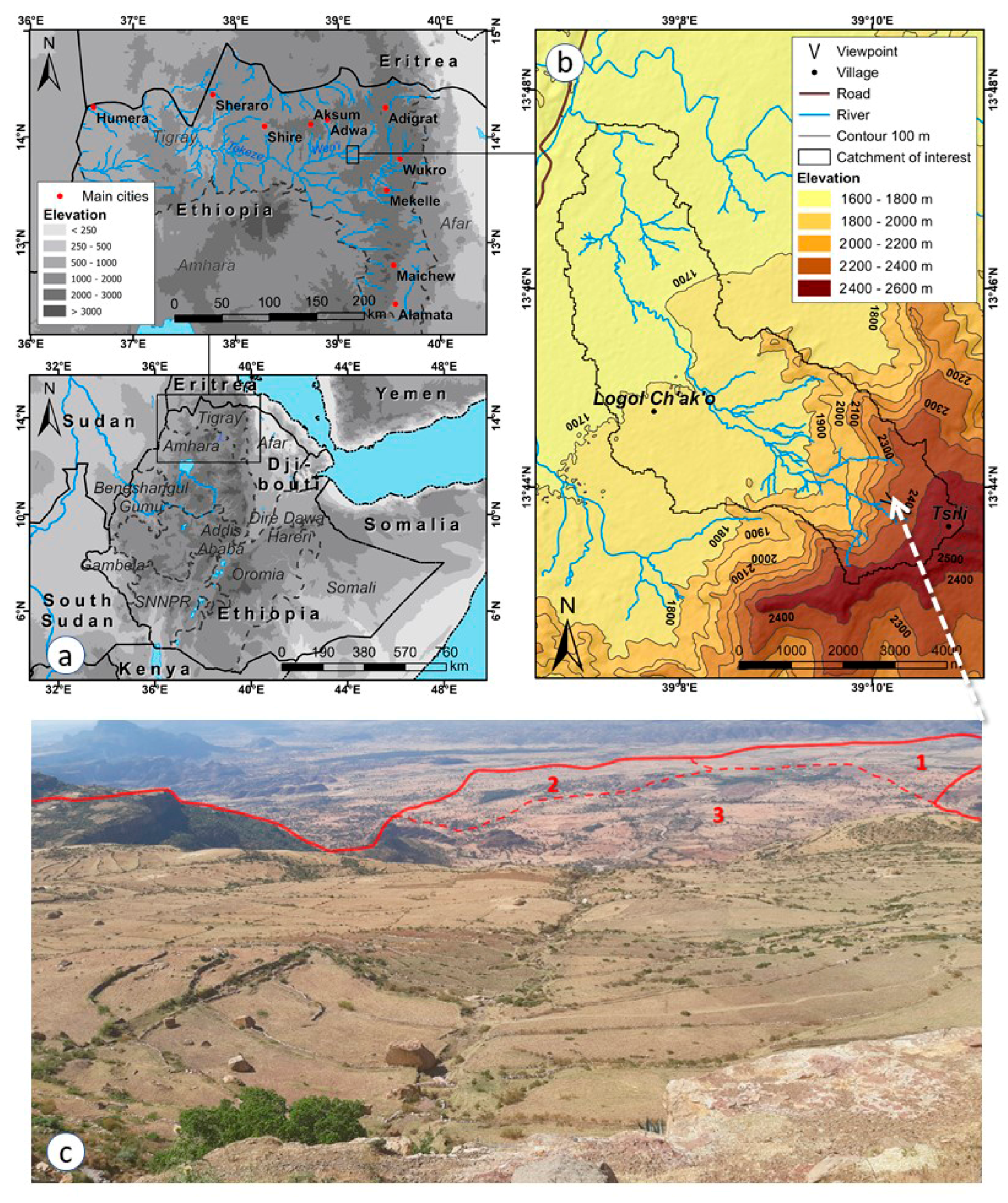
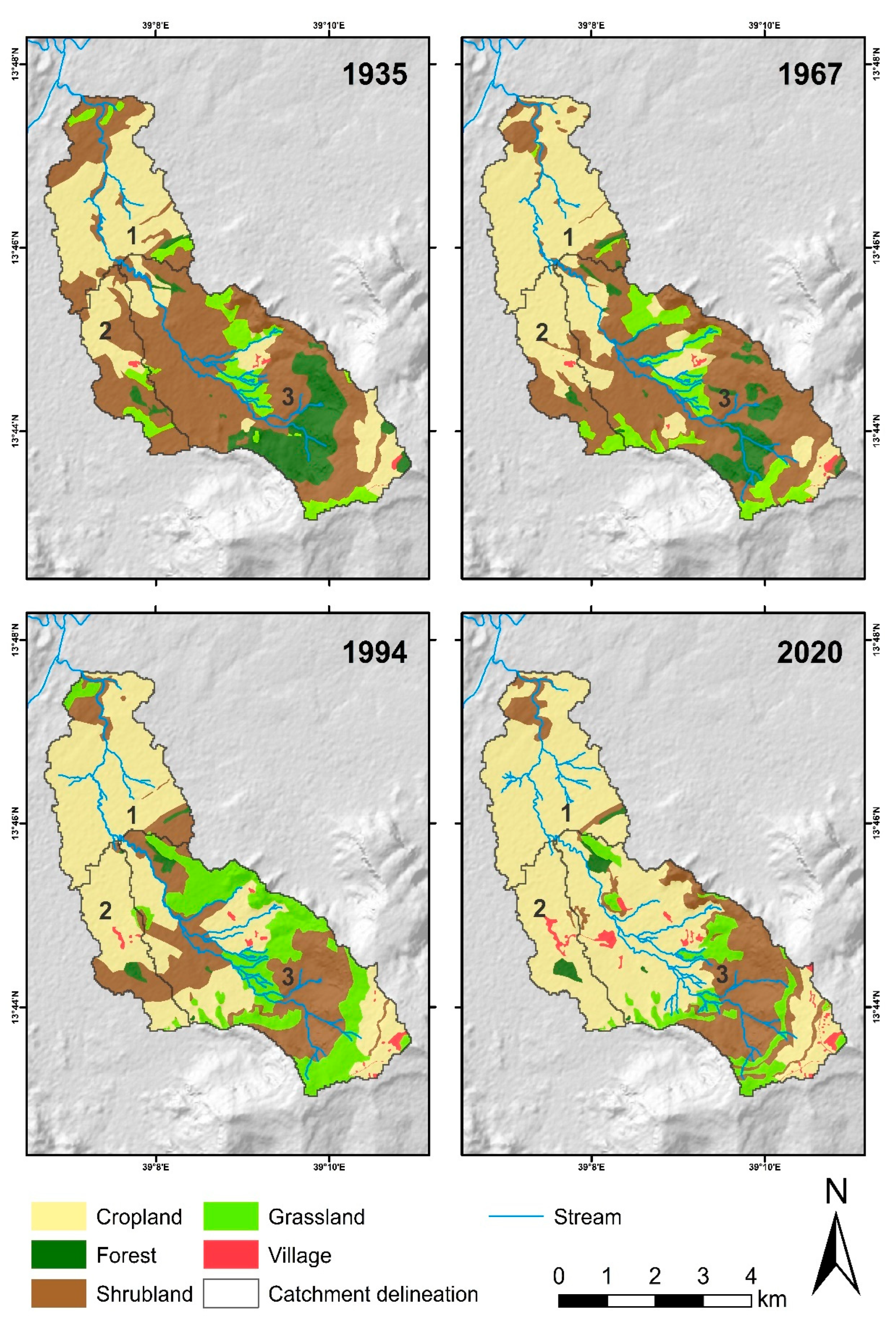
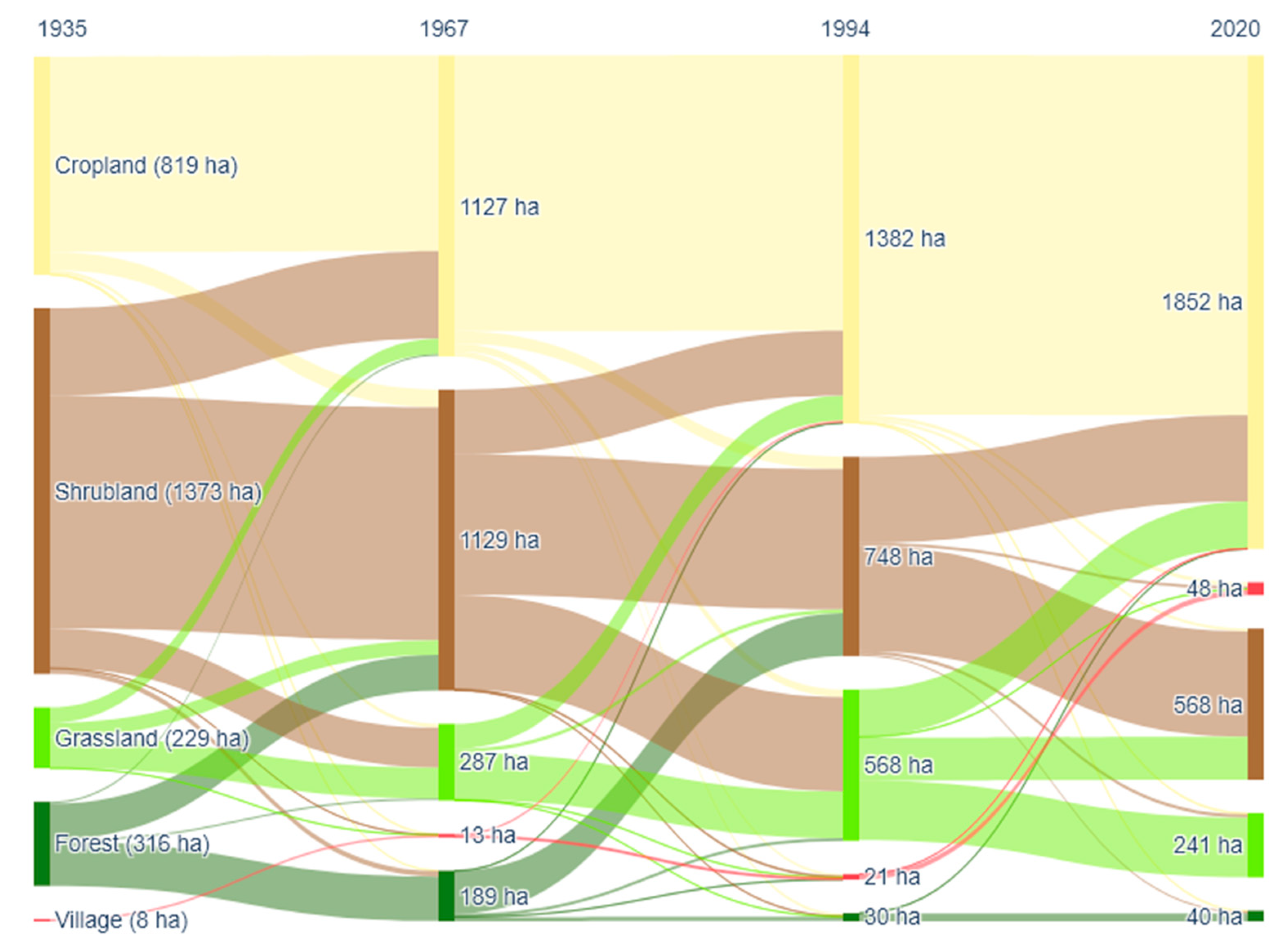
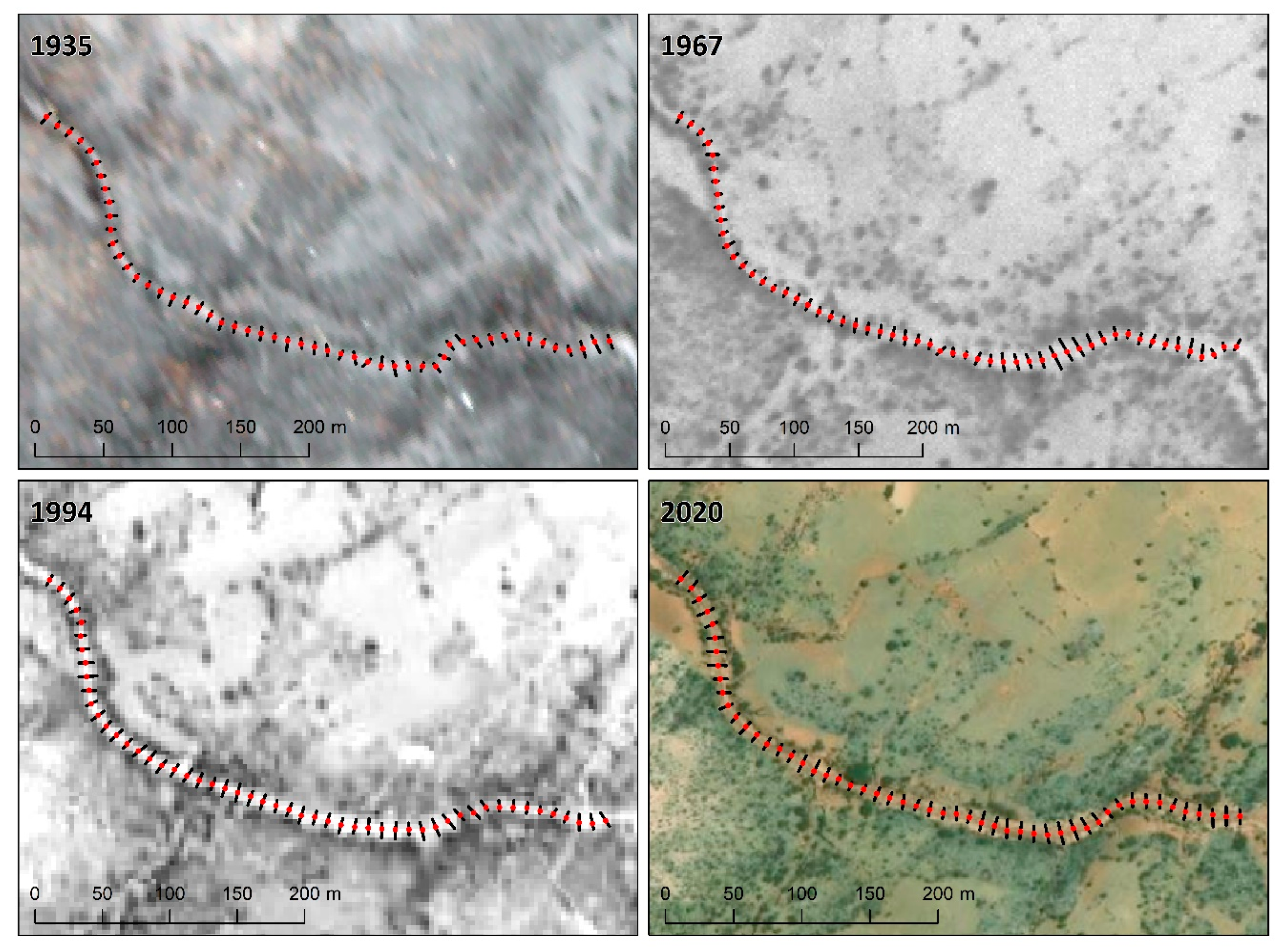
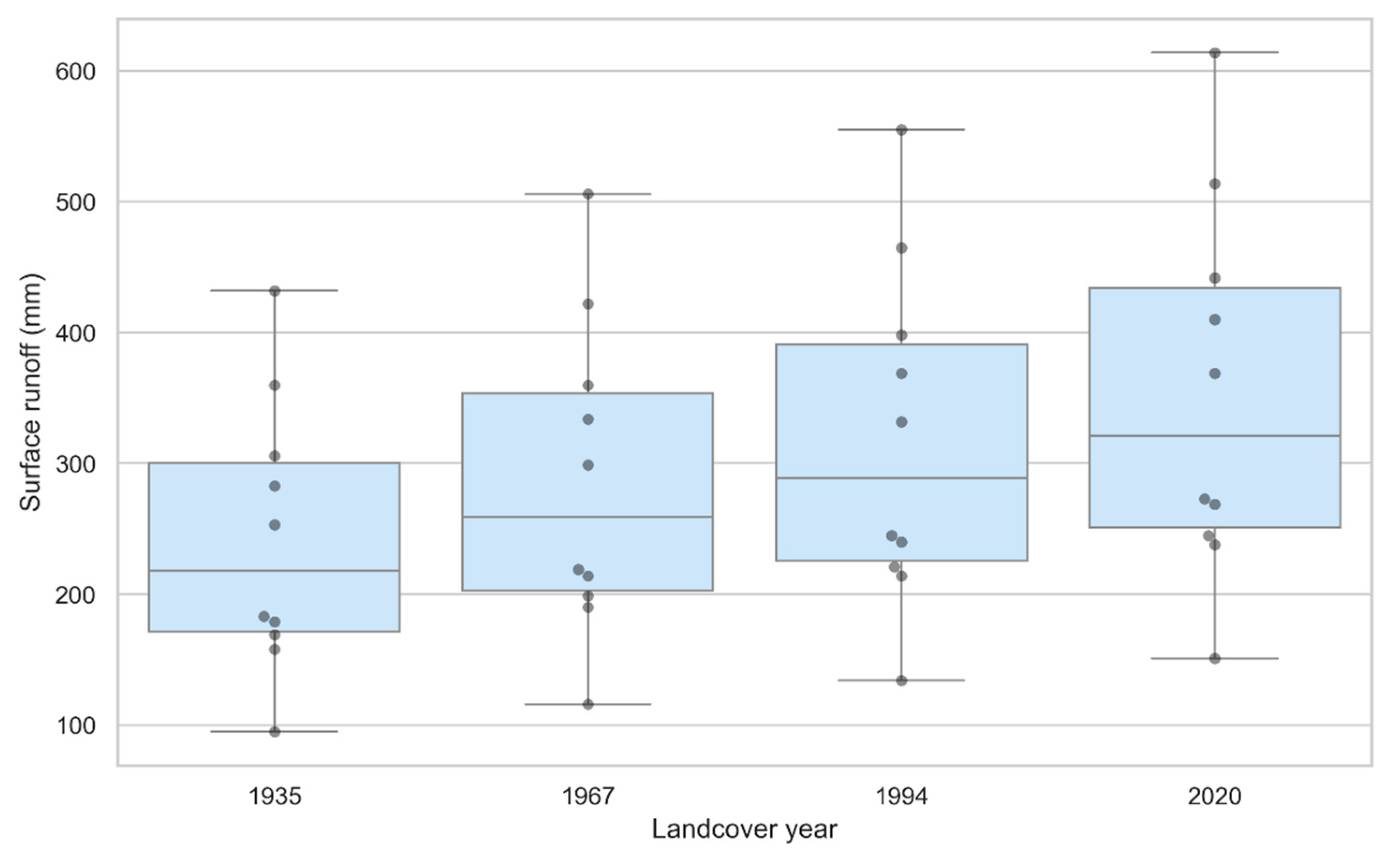
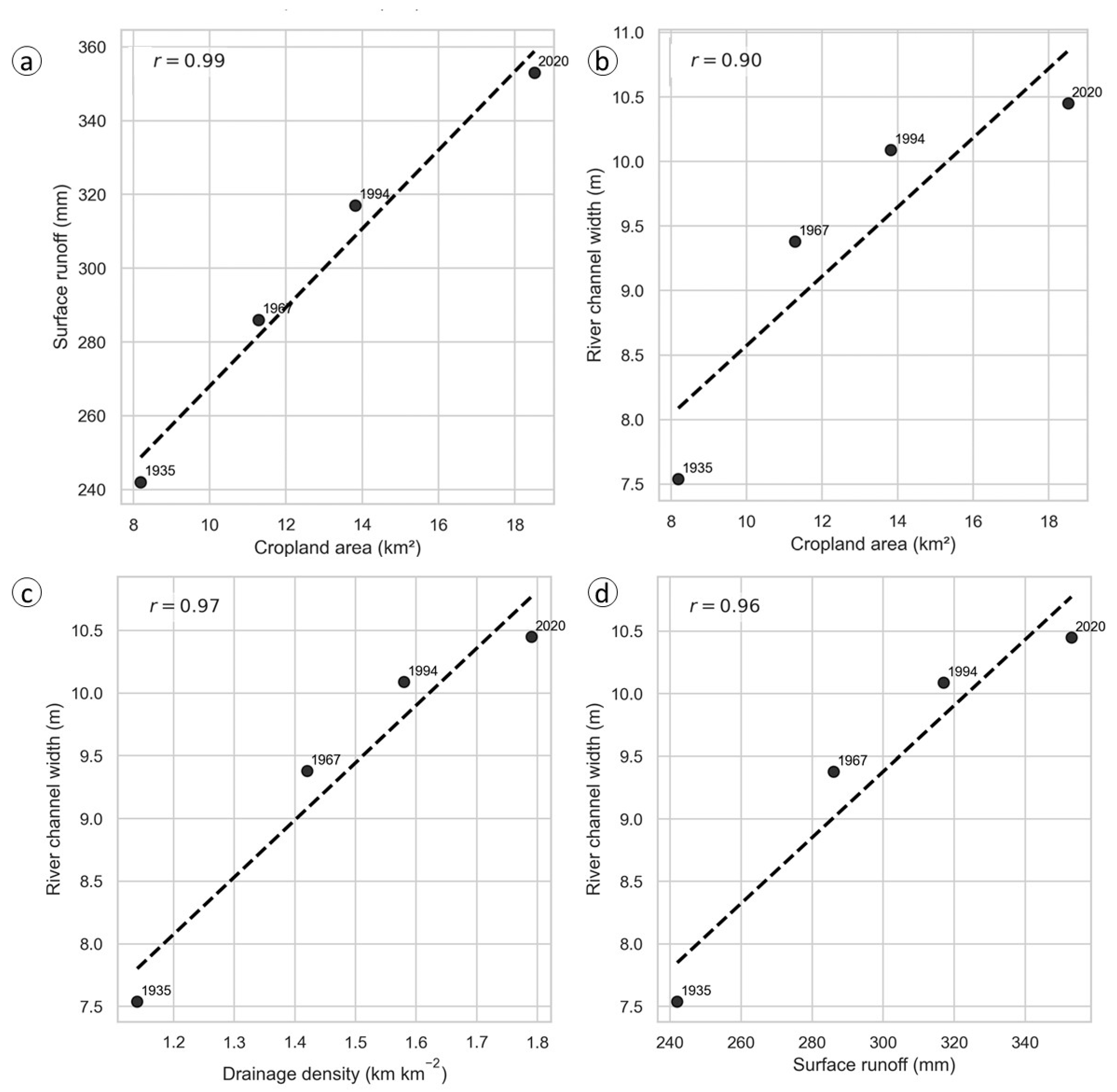
| Dominant Soil Unit | Lithology | Geological Unit | Physiographic Unit |
|---|---|---|---|
| Eutric Planosols | Siltstone and fine to coarse-grained sandstone, minor calcareous ferruginous silt and clay | Adigrat and Enticho Sandstone outcrops surrounded by large alluvial-colluvial deposits (pediplain) | Valley–Pediplain (1600–1800 m a.s.l.) |
| Lithic Leptosols | Siltstone and fine to coarse-grained sandstone, minor calcareous ferruginous silt and clay | Adigrat Sandstone | Lower half of the escarpment (1800–2000 m a.s.l.) |
| Lithic Leptosols Leptic/Skeletic Cambisols Leptic/Skeletic Regosols | Finely crystalline sandy limestone and marl Coquina, oolitic limestone and marl | Antalo Limestone | Middle escarpment (2000–2400 m a.s.l.) |
| Lithic Leptosols Calcaric Regosols | Clay, silt, sandstone, pebble conglomerate and silty clay | Amba Aradam Formation | Upper part of the escarpment (2400–2500 m a.s.l.) |
| Lithic Leptosols Pellic Vertisols | Olivine basalt with minor interbedded lacustrine deposits | Trap basalts | On the plateau (2500–2600 m a.s.l.) |
| Drainage Length (km) | Drainage Density (km−2) | |||||||
|---|---|---|---|---|---|---|---|---|
| Subcatchment | 1935 | 1967 | 1994 | 2020 | 1935 | 1967 | 1994 | 2020 |
| Sub-1 | 8.55 | 11.82 | 14.43 | 15.81 | 1.08 | 1.49 | 1.82 | 1.99 |
| Sub-2 | 0.27 | 0.32 | 0.54 | 0.92 | 0.07 | 0.09 | 0.15 | 0.25 |
| Sub-3 | 22.54 | 26.99 | 28.56 | 32.43 | 1.42 | 1.69 | 1.79 | 2.04 |
| Overall | 31.37 | 39.13 | 43.53 | 49.17 | 1.14 | 1.42 | 1.58 | 1.79 |
| Subcatchment | 1935 | 1967 | 1994 | 2020 |
|---|---|---|---|---|
| Sub-1 | 9.8 ± 4.3 | 11.7 ± 5.0 | 11.9 ± 5.0 | 12.4 ± 5.2 |
| Sub-2 | 6.6 ± 3.1 | 9.0 ± 4.0 | 10.6 ± 4.6 | 12.7 ± 5.3 |
| Sub-3 | 12.2 ± 4.9 | 13.1 ± 5.3 | 15.2 ± 5.8 | 16.7 ± 6.4 |
| Overall | 28.6 ± 12.3 | 33.8 ± 14.3 | 37.7 ± 15.4 | 41.8 ± 17.0 |
Disclaimer/Publisher’s Note: The statements, opinions and data contained in all publications are solely those of the individual author(s) and contributor(s) and not of MDPI and/or the editor(s). MDPI and/or the editor(s) disclaim responsibility for any injury to people or property resulting from any ideas, methods, instructions or products referred to in the content. |
© 2025 by the authors. Licensee MDPI, Basel, Switzerland. This article is an open access article distributed under the terms and conditions of the Creative Commons Attribution (CC BY) license (https://creativecommons.org/licenses/by/4.0/).
Share and Cite
Haegeman, K.; Negash, E.; Meaza, H.; Nyssen, J.; Dondeyne, S. Landcover Change in Tigray’s Semi-Arid Highlands (1935–2020): Implications for Runoff and Channel Morphology. Land 2025, 14, 1897. https://doi.org/10.3390/land14091897
Haegeman K, Negash E, Meaza H, Nyssen J, Dondeyne S. Landcover Change in Tigray’s Semi-Arid Highlands (1935–2020): Implications for Runoff and Channel Morphology. Land. 2025; 14(9):1897. https://doi.org/10.3390/land14091897
Chicago/Turabian StyleHaegeman, Kiara, Emnet Negash, Hailemariam Meaza, Jan Nyssen, and Stefaan Dondeyne. 2025. "Landcover Change in Tigray’s Semi-Arid Highlands (1935–2020): Implications for Runoff and Channel Morphology" Land 14, no. 9: 1897. https://doi.org/10.3390/land14091897
APA StyleHaegeman, K., Negash, E., Meaza, H., Nyssen, J., & Dondeyne, S. (2025). Landcover Change in Tigray’s Semi-Arid Highlands (1935–2020): Implications for Runoff and Channel Morphology. Land, 14(9), 1897. https://doi.org/10.3390/land14091897






